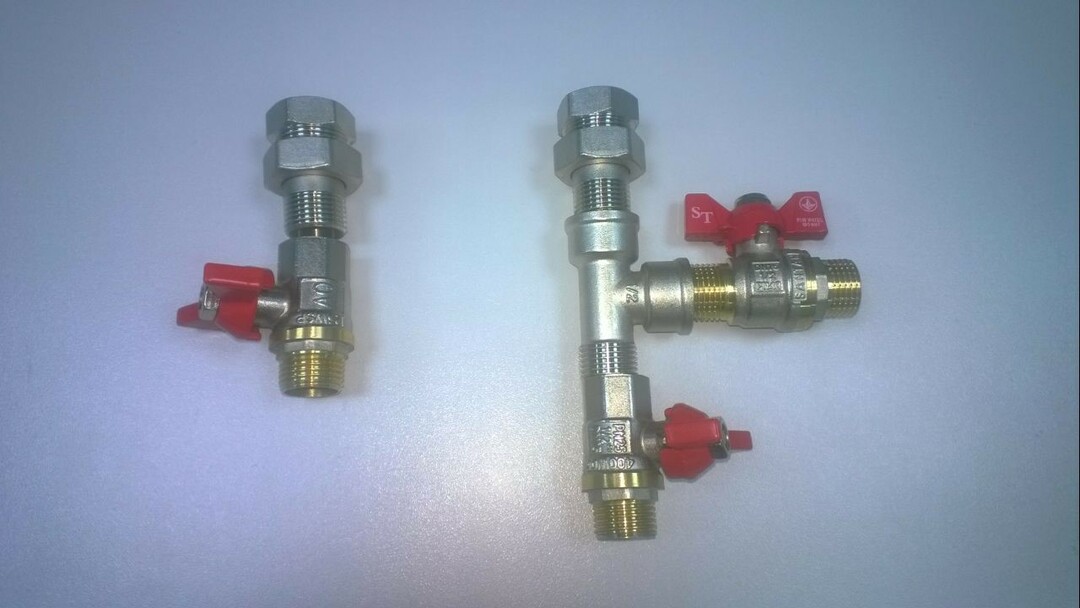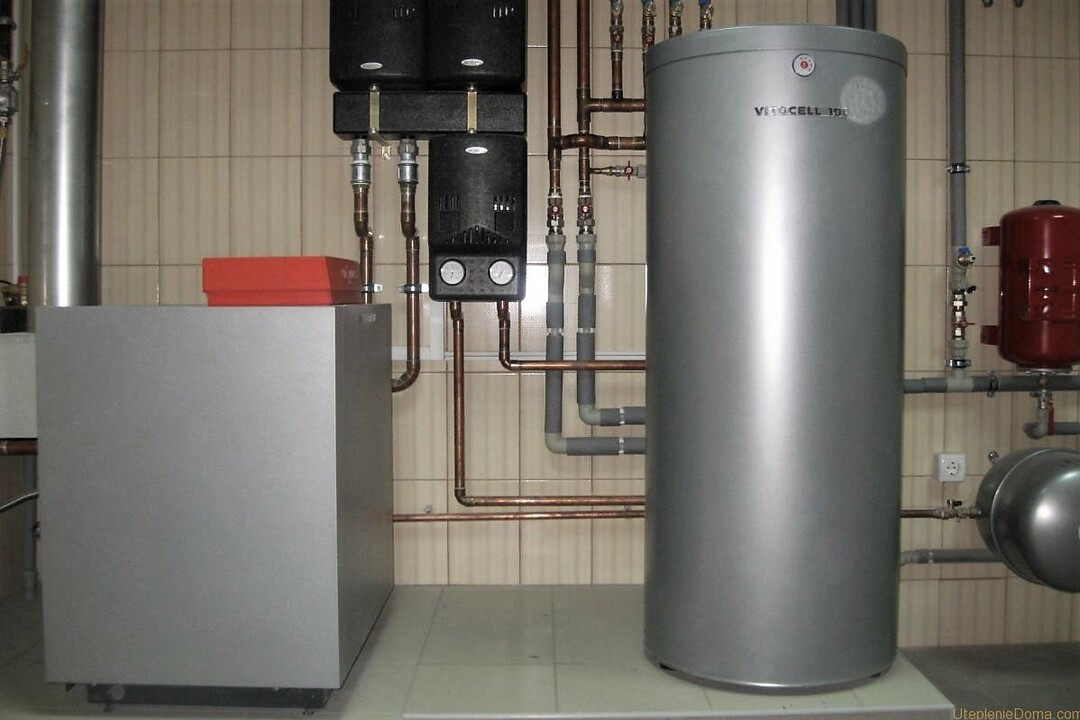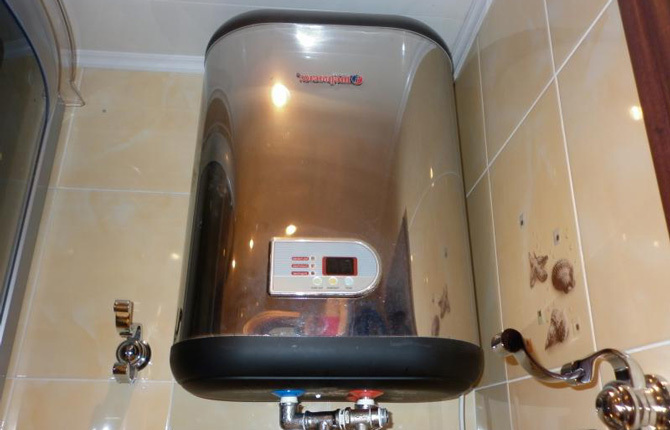Induction heating boilers - are devices that have a very high efficiency. They can significantly reduce energy costs compared to conventional devices equipped with heating elements.
Industrial Models expensive. However, to make an induction heater with your hands can any handyman holding simple set of tools. To help him, we offer a detailed description of the operating principle and build effective heater.
The content of the article:
- The operating principle of an induction heater
- Advantages and disadvantages of the device
- manufacturing steps homemade
- A few words about safety
- Conclusions and useful videos on the topic
The operating principle of an induction heater
Induction heating is possible without the use of three basic elements:
- inductor;
- generator;
- heating element.
The inductor coil is typically formed of copper wire, with its help generate a magnetic field. The alternator is used to produce high flow from standard household power with a frequency of 50 Hz.
As a heating element applied metal object capable of absorbing thermal energy by the applied magnetic field. If properly combine these elements, it is possible to obtain a high-performance appliance that is perfect for heating a heat transfer fluid and
home heating.With an electric current generator with the required characteristics is applied to the inductor, i.e. a copper coil. When passing through it a stream of charged particles forms a magnetic field.

The operating principle of induction heaters is based on the occurrence of electric current in the conductor, appearing under the influence of magnetic fields
The feature field is that it has the ability to change the direction of high-frequency electromagnetic waves. If this field put any metal object, it will start to heat up without any direct contact with the inductor under the influence created by the eddy currents.

High-frequency electric current supplied from the inverter to the induction coil generates a magnetic field with a constantly changing magnetic vector waves. Put in this field is the metal heats up quickly
No contact leads to loss of energy during the transition from one form to another is negligible, which explains the increased efficiency of induction boilers.
To heat water for the heating circuit is sufficient to ensure its contact with the metal heater. Often used as a heating element metal tube, through which was passed a stream of water. The water cools the heater, which significantly increases its service life.

Induction electromagnet device is obtained by winding a wire around a core of ferromagnetic. The resulting induction coil heats up and transfers heat to a heated body or heating medium flowing through the heat exchanger adjacent
Advantages and disadvantages of the device
"Plus" in the vortex induction heater in abundance. It is simple for individual processing circuit, high reliability, high efficiency, relatively lower energy costs, long life, low likelihood of breakdowns and etc.
Device performance may be significant, units of this type have been successfully used in the steel industry. By heating the coolant rate of this type of device confidently compete with conventional electric boilers, water temperature in the system rapidly reaches the desired level.
During operation of the boiler induction heater vibrates gently. This vibration shakes the metal tube from the wall of limescale and other possible contamination, so a cleaning device needs very rarely. Of course, the heating system must be protected from these contaminants by a mechanical filter.

The induction coil heats the metal (tube or wire pieces) placed inside it, by means of high-frequency eddy currents, the contact is not required
Constant contact with water to minimize the probability of heater burnout, which is quite a common problem for traditional boilers with heating elements. Despite the vibration to the boiler is exceptionally quiet, extra insulation in place of the device does not need installation.
Another induction heaters are good that they almost never occur unless the system installation is correct. This is a very valuable asset for electrical heatingBecause it eliminates or significantly reduces the risk of dangerous situations.
No leakage caused by non-contact method of transmitting thermal energy of the heater. The coolant can warm up to almost vaporized using the technology described above.
It provides sufficient thermal convection to stimulate the efficient movement of coolant through the pipes. In most cases, the heating system does not have to be equipped with a circulating pump, although it all depends on the characteristics of the particular scheme and the heating system.
Sometimes circulation pump needs. Set the device is relatively simple. Although it will need some skills and installation of electrical heating pipe. But there is this convenient and reliable instrument a number of disadvantages, which should also be considered.
For example, the boiler heats the coolant is not only, but also all its surrounding workspace. It is necessary to allocate a separate room of the unit and remove any foreign objects. For a man a long stay in the vicinity of operating boilers can also be unsafe.

For operation of the induction heater requires electric current. As home-made and factory-built equipment is connected to the household AC
The instrument requires electricity. In areas where access to the benefits of civilization is absent, the induction boiler will be useless. And where there are frequent power outages, he will demonstrate low efficiency. By careless handling of the device may explode.
If the coolant to overheat, it will turn into steam. As a result, the pressure in the system will increase dramatically, then the tube is simply not survive, they will break. Therefore, for normal operation the unit must be provided with a minimum gauge, and even better - an emergency shutdown, temperature controller, etc.
All this can significantly increase the cost of a homemade induction boiler. While the device is considered virtually silent, this is not always the case. Some models, for various reasons may still emit some noise. For a device configured independently, the probability of such an outcome increases.

The design of both factory and home-made induction heaters virtually no wearing components. They are long and flawlessly
manufacturing steps homemade
To make such a device alone is not too difficult. You will need:
- To make the heating element.
- Make inductor coil of copper wire.
- Get ready alternator.
- Attach heater coil to the heating system.
- Connect the coil to the generator.
- Bring the power supply to the system.
- Make a test run to check the operation of the unit.
In industrial models as a heater uses a metal tube with thick walls, but provide sufficient capacity homemade device to heat an element, it is very difficult and does not make much sense It has. Induction coil capable reheat any metal, so the heater can be modified.

Industrial model induction boilers provided with a heating element made of a thick metal tube. At home, a copy machine is difficult
As for the housing of the induction heater uses an inverter welding plastic pipe segment. It should be slightly larger in diameter than the heating pipes. The length of the heater tube may be about one meter, internal diameter can be varied between 50-80 mm.
For connecting the heater to the system should be established in the adapter lower and upper housing part. The lower part of the tube needs to be closed bars, and then placed inside the casing filler consisting of small metal particles. Get filler can be, an example of the wire rod, a narrow metal pipe, etc.
length of the segments can be varied arbitrarily. Most often, this is done using a steel wire 8.6 mm in diameter, which just is cut in small pieces. Some masters recommend to cut her long rods, approximately 90 cm, ie, almost the length of the heater.

For housing induction heating element of the boiler, which produced his own hands, will need broad, about 50 mm in diameter, plastic pipe
The higher magnetic resistance of steel, which wire is made, the better it will be heated. Depending on the size of the pieces chosen and the safety net, which is mounted at the bottom of the housing. The filler is poured or placed into the tube to the top. Thereafter, the upper part is also closed mesh.

The scheme gives an idea of how to connect an induction coil heater to the boiler and to the welding machine
Thus, the induction heater homemade boiler looks like thick plastic pipe, metal pieces stuffed and closed on both sides of the mesh. Top and bottom of the heater has adapters for connection to the heating circuit. Polymer heater tube must have a sufficiently thick wall.
In addition, any plastic material for this purpose is not suitable, the material must endure rather strong heating effect and not released into the atmosphere or into the coolant no hazardous substances. Now you can make your induction grille. To do this, take the copper wire and wound it directly on the body of the heater.

In some models of home-made induction heaters instead of a plastic pipe using a narrow copper tube. This is not the best option, because the right to curtail an element in a spiral will be difficult
The more turns of wire, the better. It is believed that the induction coil must be at least 90 turns. The inductor is wound on the pipe is very tight, between the turns there should be no gap.
Suitable for winding copper insulated wire 1-1.5 mm. Thicker cables are not needed here, because he works on winding more difficult, more difficult to arrange the turns closely.

This scheme will help to connect the inductor coil to the inverter welding machine, if not done properly, will become a magnet coil (+)
The presence of gaps can cause noise occurrence due to vibration, which is accompanied by such a work machine. Over time, this situation can lead to the destruction of the insulation, causing interturn short circuit.
Top and bottom addition of adapters should be installed shut-off valves. They need to be able, if necessary, cut off the water in the heating circuit.
Installation of the heater should be remembered that its lower end should be directed to the return pipe, tube, intended for collecting the cooled coolant in two-pipe heating system. The easiest way to get a generator of alternating field - to take from the inverter welding machine.
Contact the induction coil is connected to an inverter poles. As soon as the power supply to the unit fail and incorporate it into the network homemade induction boiler starts.
For the manufacture of such a device suitable even inexpensive welding machine, for example, a model in China, which allows you to adjust the strength of the current, starting from the level of 10 A. Near the adapter on the pitch should set the thermostat sensor. Connecting the welding inverter is done via the thermostat.
At the outputs necessary to put the rectifier diodes. It will have to open the casing of the welding machine and solder wires to the door, and then attach them to the diodes. If the connection without diode directly, the coil current will go to the rectified voltage and the coil will act as a magnet and not as an inductor.

To create an induction spiral is recommended to use the copper wire of 1.5 mm in cross section reliable insulating jacket, it is necessary to make about 90 turns
In certain modern welding apparatus has a touch sensor, which starts operation when the electrode touches the working surface. This point must be taken into account that the sensor or triggered at the right time, or do not affect the operation of a self-made boiler.
If reworking welder inexperienced master problems, it is best to seek professional advice.

For the manufacture of induction boilers with their hands can take any welder with suitable characteristics. If necessary, the device can be re-used for welding
If done correctly, welding machine can be used for its intended purpose in the future. You will need to unsolder the wires with diodes and make reassembly. Under the influence of high-frequency alternating current induction coil creates a magnetic field.
The metal inside the polymer body will begin to heat and transfer heat to the water that circulates through the heating circuit. On warming of the coolant device need only a few minutes.
Place for induction heater should be selected correctly. The unit must be located 800 mm below the ceiling, and the walls and pieces of furniture it should be separated at least 300 mm.
A few words about safety
Self-made induction heaters are not usually equipped with a control and protection systems, making them unsafe. Therefore, before switching on the unit make sure that the body cavity is filled with heat transfer fluid.
If the polymer heater housing will be continuously heated coolant without washing it just melted, sometimes it leads not only to the heater deformation, but also to its full damage.

Units of this type are often used to raskalivaniya and metals smelting. The high temperatures produced by the induction heater, require careful attention to security issues
Can be dangerous and loss of hot metal filler melt housing. In this case, it will have to almost completely disassemble the device and make a new heating element for him.
Electrical connection should be performed by a separate cable, carried out by panel. Of course, you must carefully close the insulation all contacts. Inverter welding machine also must be grounded, an important point for safety.
This will take a section of cable is not less than four millimeters. Some experts recommend to give preference to six-millimeter cable. To prevent overheating induction heater improvised due to lack of water in the system, it is recommended to set at the inlet to the heater overpressure valve.

The induction heating device takes up relatively little space, but it needs to be placed at a certain distance from the ceiling, walls, furniture, etc.
Homemade device of this type is not equipped with special protective devices, it is a potentially dangerous object, which requires constant monitoring. Therefore it is worthwhile to spend a little more money, but to get the necessary devices.
It does not hurt to estimate the cost, may purchase the finished induction boiler will cost not much more expensive. Industrial devices are usually equipped with all necessary protections.
Features and step manufacturing process of another embodiment of homemade induction boiler for heating systems listed here.
Conclusions and useful videos on the topic
Clip # 1. Overview of induction heating principles:
Clip # 2. An interesting variant of the induction heater manufacturing:
To install an induction heater does not need to obtain regulatory approval, industrial models of these devices are safe, they are also suitable for private homes, and for routine apartment. But the owners of improvised units do not forget about safety.
Comment, please, we proposed to the familiarization material. Ask questions to interesting or obscure points. Perhaps you have your own experience in the construction or installation of the induction of the boiler? Share and publish unique photo, you can block the comments underneath.


